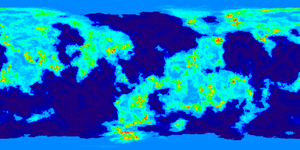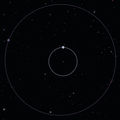Difference between revisions of "Kerbin"
UmbralRaptor (talk | contribs) (Tweaks/updates for 0.17.) |
(Cleanup -- consolidate the Trivia section into the Changes list.) |
||
| Line 34: | Line 34: | ||
}} | }} | ||
| − | '''Kerbin''' is a planet which is home to the [[Kerbal Space Center|Space Center]] and the main focus of [[Kerbal Space Program]]. It has two [[moon]]s, named '''[[Mun]]''' and '''[[Minmus]]'''. It is the third planet in [[orbit]] around the [ | + | '''Kerbin''' is a planet which is home to the [[Kerbal Space Center|Space Center]] and the main focus of [[Kerbal Space Program]]. It has two [[moon]]s, named '''[[Mun]]''' and '''[[Minmus]]'''. It is the third planet in [[orbit]] around the [[w:Stellar_classification#Class_M|M class]] star [[Kerbol]]. It is the third largest planet (after [[Jool]] and [[Eve]]) and the fourth largest celestial object around Kerbol (the moon [[Tylo]] being slightly larger). |
== Topography == | == Topography == | ||
[[File:Kerbin ISA Topo.png|left|thumb|Topographical image of Kerbin.]] | [[File:Kerbin ISA Topo.png|left|thumb|Topographical image of Kerbin.]] | ||
| − | Kerbin has a roughly equal distribution of surface liquid water and solid land, with polar icecaps and scattered deserts. There are mountains exceeding | + | Kerbin has a roughly equal distribution of surface liquid water and solid land, with polar icecaps and scattered deserts. There are mountains exceeding 3 km in height, with the tallest peak being at least 3750 m in altitude.<ref>http://kerbalspaceprogram.com/forum/index.php?topic=11388.msg176509#msg176509 {{broken link}}</ref> |
| Line 48: | Line 48: | ||
== Orbits == | == Orbits == | ||
| − | Geosynchronous orbit is achieved at an altitude of | + | Geosynchronous orbit is achieved at an altitude of |
| + | {{OrbitAltitude | period_s=21600 | mass_kg=5.292e22 | radius_km=600 }}. A semi-synchronous orbit with an orbital period of 1/2 of Kerbal (3 hours or 10800 seconds) is achieved at an altitude of | ||
| + | {{OrbitAltitude | period_s=10800 | mass_kg=5.292e22 | radius_km=600 }} with an orbital velocity of | ||
| + | {{OrbitVelocity | period_s=10800 | mass_kg=5.292e22 | radius_km=600 }}. | ||
== Interplanetary Travel == | == Interplanetary Travel == | ||
| − | From the lowest stable orbit around Kerbin ( | + | From the lowest stable orbit around Kerbin (70 km), the amount of delta-V needed to reach the orbits of other celestials is as follows: |
{| class="wikitable" | {| class="wikitable" | ||
| Line 129: | Line 132: | ||
== Gallery == | == Gallery == | ||
<gallery> | <gallery> | ||
| − | + | NJ6qJ.jpg | A projection map of Kerbin, as of {{version|0.14.1|}} and before (including the demo). | |
| − | + | Kerbin color.png | An accurate full-colour projection map of Kerbin as of {{version|0.14.2|}} and above. | |
| − | + | Kermmunist_Launch_Site.png | The second launch site (currently unused). | |
| − | + | Kerbin_mun_minmus.jpg | Kerbin, Mun and Minmus. | |
</gallery> | </gallery> | ||
| − | |||
| − | |||
| − | |||
| − | |||
== Changes == | == Changes == | ||
| Line 145: | Line 144: | ||
* [[Minmus]] added. | * [[Minmus]] added. | ||
;{{Version|0.14.2|}} | ;{{Version|0.14.2|}} | ||
| − | * Much more varied and taller terrain added. | + | * Much more varied and taller terrain added. Prior to this, some mountain ranges exceeded 600 m in height, but the tallest point was at an altitude of approximately 900 m.<ref>http://kerbalspaceprogram.com/forum/index.php?topic=6446.0 {{broken link}}</ref> |
;{{Version|0.12|}} | ;{{Version|0.12|}} | ||
* [[Mun]] added. | * [[Mun]] added. | ||
Revision as of 07:40, 16 October 2012
Kerbin is a planet which is home to the Space Center and the main focus of Kerbal Space Program. It has two moons, named Mun and Minmus. It is the third planet in orbit around the M class star Kerbol. It is the third largest planet (after Jool and Eve) and the fourth largest celestial object around Kerbol (the moon Tylo being slightly larger).
Contents
Topography
Kerbin has a roughly equal distribution of surface liquid water and solid land, with polar icecaps and scattered deserts. There are mountains exceeding 3 km in height, with the tallest peak being at least 3750 m in altitude.[1]
Atmosphere
Kerbin has an atmosphere of unknown composition, though because Kerbin has plants and animals, it can be assumed there is O2, N2, and CO2. The atmosphere ends at 69,077.55 meters and, as on Earth, becomes exponentially less dense as altitude increases (with a scale height of 5 km).[2] In general, the atmospheric pressure and density on Kerbin, at an altitude expressed in meters, are:
Orbits
Geosynchronous orbit is achieved at an altitude of 0.00 m. A semi-synchronous orbit with an orbital period of 1/2 of Kerbal (3 hours or 10800 seconds) is achieved at an altitude of 0.00 m with an orbital velocity of 0.00 m/s.
Interplanetary Travel
From the lowest stable orbit around Kerbin (70 km), the amount of delta-V needed to reach the orbits of other celestials is as follows:
| Body | Delta-V | |
|---|---|---|
| Mun | ~860 m/s | |
| Minmus | ~930 m/s | |
| Eve | ~1033 m/s | |
| Duna | ~1060 m/s | |
| Moho | ~1676 m/s | |
| Jool | ~1915 m/s | |
Reference Frames
| Paid (0.17) | Demo (0.13.3) | |
|---|---|---|
| Rotational/Inertial transition | 100,000 m | 70,000 m |
| Warp | Minimum Altitude | |
| 1x | Any | |
| 2x | n/a | 0 m |
| 5x | 69,078 m (above the atmosphere) | |
| 10x | 69,078 m (above the atmosphere) | |
| 50x | 69,078 m | 150,000 m |
| 100x | 120,000 m | 300,000 m |
| 1,000x | 240,000 m | 600,000 m |
| 10,000x | 480,000 m | 1,200,000 m |
| 100,000x | 600,000 m | n/a |
Gallery
- NJ6qJ.jpg
A projection map of Kerbin, as of 0.14.1 and before (including the demo).
An accurate full-colour projection map of Kerbin as of 0.14.2 and above.
Changes
- Improved atmosphere visuals.
- Minmus added.
- Much more varied and taller terrain added. Prior to this, some mountain ranges exceeded 600 m in height, but the tallest point was at an altitude of approximately 900 m.[3]
- Mun added.
- Terrain overhaul, oceans became wet.
- Atmosphere extended from ~34,500 m to ~69,000 m.
- Initial Release
Notes
- ↑ http://kerbalspaceprogram.com/forum/index.php?topic=11388.msg176509#msg176509 [Broken Link]
- ↑ Forum thread 16000, "[KGSS] Examining Kerbin's atmosphere"
- ↑ http://kerbalspaceprogram.com/forum/index.php?topic=6446.0 [Broken Link]





